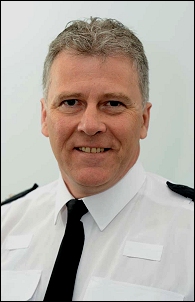Burnham-On-Sea police inspector Roger Tolley has this week moved to address concerns about speed signs and enforcement in the town.
It comes after one irate motorist erected his own speed signs along Burnham’s Love Lane, as we reported here, after being caught speeding.
Inspector Tolley, right, said: “There has been some concern voiced recently in the community and I am keen to clarify certain misconceptions amongst some drivers in respect of the signage provided on Restricted Roads.”
“In the UK Highway Code, a built-up area is a settled area in which the speed limit of a road is automatically 30mph (48 km/h). These roads are known as ‘restricted roads’ and are identified by the presence of street lights. There are some complicated details of what street lights are and how far apart they can be, however, the conclusion is that it should be assumed that, unless an order has been made and the road is signed to the contrary, a 30 mph speed limit applies where there are three or more lamps throwing light on the carriageway and placed not more than 183 metres apart.”
He added: “In respect of the use of repeater signs to remind drivers that a built up area has a speed limit of 30mph, direction 11 of The Traffic Signs Regulations and General Directions 2002 (TSRGD 2002) defines the requirements for the placing of speed-limit repeater signs. This states that speed-limit repeater signs cannot be placed along a road on which there is carriageway lighting not more than 183 metres apart and which is subject to a 30 mph speed limit. The Department will not make exceptions to this rule.”
“Speeding is and always has been a perennial problem for communities across the country. Enforcement is now provided by this Constabulary as opposed to the Safety Camera Partnership who were responsible until recently. The Constabulary secures details of potential problematic sites for detection work from a range of sources rather than simply collision data as it has been in the past. These sources include speed data (rubber tubes across the road), District and County Council data, Community Speed Watch groups, and from local policing priorities where members of the public have highlighted speed as a local issue, as well as collision data. The deployment of camera enforcement teams will only be conducted where they can park legally and where the relevant signage to identify a ‘restricted road’ is correct.”
“The policy on prosecution is as follows – prosecutions start where the speed of the motorists is recorded as exceeding the limit + 10% + 2mph. Therefore on a restricted road if you travel at 35 mph (30mph + 3 (10% of the limit to account for defects in the speedometer) + 2 mph = 35) you can expect to receive a notice of intended prosecution. If you are recorded as travelling between 35 mph and 42 mph, you will be offered the option of attending an educational event that will help you appreciate the dangers of speeding. Attending this event will cost you the same as a fine but you avoid receiving points (endorsement) on your license. If you choose not to attend, you can pay the fixed penalty charge and the requisite number of points will be endorsed on your license. Travelling between 43 and 49 mph, there is no choice and you will receive a fixed penalty notice. Over 50 mph on a 30 mph restricted road, will result in being summonsed to court.”
“The responsibility is upon the driver to know the speed limits of the road on which they are travelling. Repeater signs are not allowed. Every driver signs a declaration when getting their driving license, stating they will keep up with changes in the law. If you get caught, however vehemently you protest that this was the first time you exceeded the limit, have had an exemplary driving record for years or the real offenders never get caught, it is because you have become part of the problem, you were speeding at that time and location and were putting others at unnecessary risk. Many of the community will have asked that speeders at that site be given tickets when they offend in order to help reduce speed in that area.”
“If you perceive speeding as a problem in your area and you would like to become part of a volunteer community speed watch group, please contact your local beat manager, who will help you in helping us to keep our roads safe.”
Further information is available in the Highway Code and from the Department of Transport.







